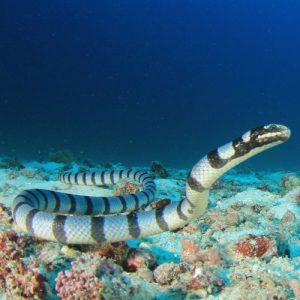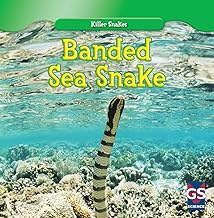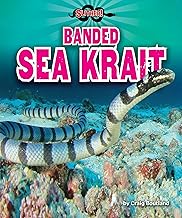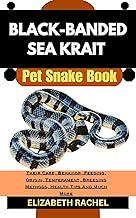Dedicated to Making Science Reader-Friendly for Children
What you need to know to use this site:
Wild animals do not make good pets.
Banded Sea Krait

The Banded Sea Krait is a type of sea snake that can be found in coral reef and rocky shore habitats, in the eastern Indian and western Pacific Oceans. It gets its name from the dark bands that spread across its white body. Sea Kraits spend time in the ocean and on land. Like other marine reptiles, such as sea turtles, they lay their eggs on land. They also come ashore to drink freshwater, digest their food, rest and to shed their skin. While in the water, Banded Sea Kraits can hold their breath for long periods of time. They have a specially adapted body that is well-suited to swimming to help them.
![]() Size: Females can reach up to 50 inches (128 cm) long, whilst males are smaller and reach up to 30 inches (75 cm) long
Size: Females can reach up to 50 inches (128 cm) long, whilst males are smaller and reach up to 30 inches (75 cm) long
![]() Distribution: Tropical to warm temperate regions in the Indian Ocean and Western Pacific Ocean. They are specifically found in coral reef and rocky shore habitats
Distribution: Tropical to warm temperate regions in the Indian Ocean and Western Pacific Ocean. They are specifically found in coral reef and rocky shore habitats
![]() Diet: Eels
Diet: Eels
![]() Behavior: Spend an average of 15 – 30 minutes underwater before they have to surface for air
Behavior: Spend an average of 15 – 30 minutes underwater before they have to surface for air
![]() IUCN Status: Least Concern
IUCN Status: Least Concern
Facts about Banded Sea Kraits
- Scientific Name: Laticauda colubrina
- Common Names: Banded sea krait, yellow-lipped sea krait, colubrine sea krait
- Basic Animal Group: Reptile
- Size: 34 inches (male); 56 inches (female)
- Weight: 1.3-4.0 pounds
- Lifespan: Unknown. Most snakes can reach 20 years of age under ideal conditions.
- Diet: Carnivore
- Habitat: Indo-Pacific region
- Population: Stable, probably numbering in the thousands
- Conservation Status: Least Concern
:max_bytes(150000):strip_icc()/sea-krait-distribution-5b61b95b4cedfd0050790847.jpg)



Ask me a question about animals at mjnickum@gmail.com .
Your answer will appear on the "Answers to Questions" page.